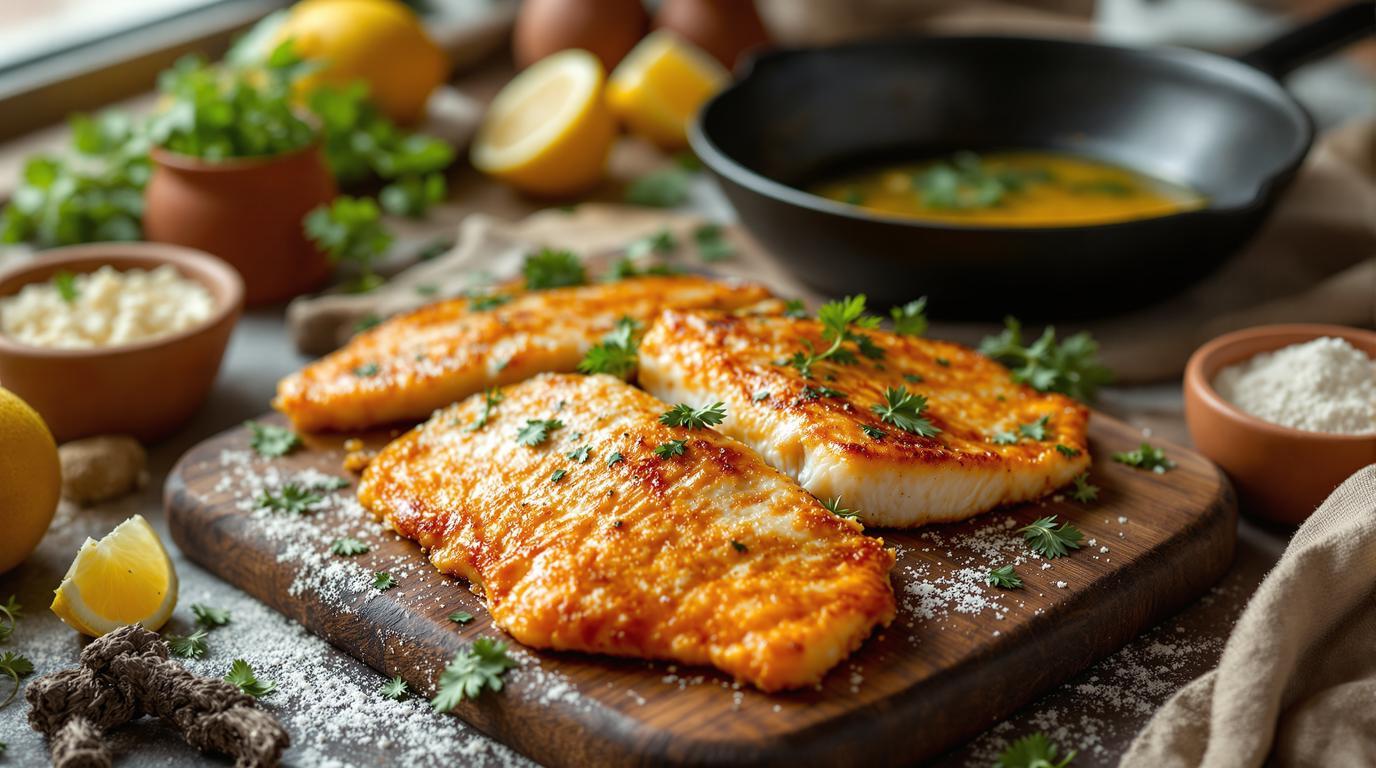There’s something utterly magical about a perfectly pan-fried fish – that moment when your spatula slides under the golden crust with just the right amount of resistance before giving way. Growing up, my grandmother demonstrated this simple yet profound technique hundreds of times, and it became my culinary north star long before I attended culinary school. This Romanian-inspired method transforms humble white fish into a masterpiece of texture and flavor in just 15 minutes, using nothing more than four ingredients that most home cooks already have in their pantry.
The Perfect Simplicity of Pan-Fried Fish 🐟
What I love most about this traditional method is that it honors the fish itself. Unlike many modern recipes that bury seafood under complicated sauces or excessive seasonings, this approach celebrates the clean, delicate flavor of white fish. My Romanian grandmother would say, “When the fish is fresh, let it sing its own song.” Having cooked in restaurants across Europe and America, I can confirm her wisdom holds true across all culinary traditions.
The technique originated with Eastern European fishing communities who needed to prepare their catch quickly while preserving its delicate texture. The method has remained virtually unchanged for generations because, quite simply, it works perfectly.
Essential Ingredients 🧾
For 4 servings, you’ll need:
- 2 pounds (900g) white fish fillets (cod, trout, tilapia, or haddock)
- ½ cup (60g) all-purpose flour
- 1-2 teaspoons kosher salt
- 1 teaspoon freshly ground black pepper
- ¼ cup (60ml) high-heat neutral oil (vegetable, canola, or sunflower)
Chef’s Note: For an authentic Romanian texture, replace ¼ of the flour with cornmeal. This creates a more pronounced crunch that beautifully contrasts with the tender fish inside. If you’re cooking for someone with gluten sensitivities, rice flour makes an excellent substitute – it actually creates an even crispier finish than wheat flour.
Step-by-Step Method 📝
1. Prepare the fish: Pat your fillets completely dry with paper towels. This step is non-negotiable – moisture is the enemy of a crispy crust. I’ve seen professional chefs leave fillets uncovered in the refrigerator for an hour before cooking to remove surface moisture.
2. Season the flour: Combine flour, salt, and pepper on a large plate or shallow dish. Mix thoroughly to ensure even distribution of seasonings.
3. Heat your pan: Place a heavy-bottomed skillet (cast iron is ideal) over medium-high heat. Add oil to a depth of about ¼ inch (about 2-3 tablespoons). The oil is ready when it reaches 300-325°F (150-165°C) or when a pinch of flour sizzles gently when added.
4. Coat the fish: Just before frying, dredge each fillet in the seasoned flour, shaking off any excess. The coating should be thin and even.
5. Fry to perfection: Carefully place the fillets in the oil, leaving plenty of space between them. Cook undisturbed for about 5 minutes until deeply golden. Flip once with a fish spatula and cook for another 3-5 minutes until the second side matches.
6. Drain: Transfer to a paper towel-lined plate and sprinkle immediately with a touch more salt while hot.
The Science Behind Perfect Frying 🔬
The magic happens between 300-325°F – at this temperature range, the flour creates a moisture barrier that steams the fish from within while developing a crisp exterior. Higher temperatures will burn the coating before the fish cooks through, while lower temperatures allow oil to penetrate, resulting in greasy fish.
When working with salmon instead of white fish, you’ll want to adjust your technique slightly, as the higher fat content changes the cooking dynamics.
Serving Suggestions 🍽️
This crispy fish pairs beautifully with traditional sides. You might enjoy it with a quick potato gratin or alongside freshly baked bread. For a complete meal with global influence, consider adding Cameroonian Ndole as a side for a fascinating fusion experience.
Garnish with lemon wedges or dill pickles, which provide brightness that cuts through the richness. Wine lovers, reach for a crisp Sauvignon Blanc or sparkling wine – the acidic notes complement the fried elements perfectly.
Finish your meal with a dairy-free oat milk gelato for a light, refreshing conclusion.
Remember, in my grandmother’s kitchen, simplicity was never a compromise – it was the foundation of excellence. The humble pan-fried fish teaches us that mastery comes not from complexity but from understanding fundamentals deeply. When you nail this technique, you’ve captured centuries of culinary wisdom in fifteen magical minutes. Your kitchen will fill with that unmistakable aroma of perfectly crisped fish, and for a brief moment, my grandmother’s kitchen will live again in yours.
